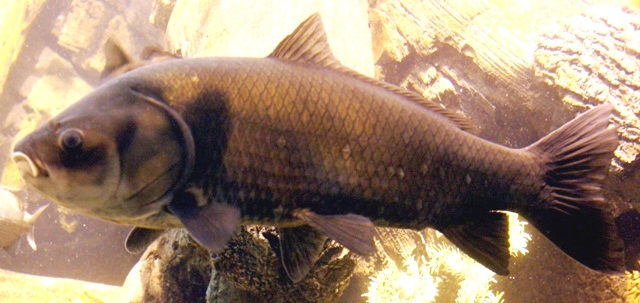Bigmouth Buffalo
(Ictiobus cyprinellus)

The name "bigmouth buffalo" refers to the large terminal mouth which means that it is not turned down, as it is in other buffalo fish and suckers. This is Ohio's largest species in the sucker family.
Description
The bigmouth buffalo has a large terminal (ending at tip of snout) mouth which helps separate them from the Black and Smallmouth Buffalo which have small sub-terminal (ending below tip of snout) mouths. Bigmouth buffalo have their eye level with the tip of the upper jaw and the other two Ohio species of buffalo have their eye positioned well above the tip of the upper jaw. They are typically a dark gray or bronze-gray, sometimes with a slight bluish overcast, and are usually darker than the smallmouth but lighter than the black buffalo in coloration. All species of buffalo have a long continuous dorsal fin and no spines in any of their fins. Buffalo look similar to common carp but are not closely related.
Habitat and Habits
The bigmouth buffalo is native to Ohio, and found in both the Ohio River and Lake Erie drainage. It is typically found in large rivers including the Ohio River and others such as the, Scioto River, Muskingum River, Maumee River, and Sandusky River. It is also found in the marshes of Sandusky Bay and other similar backwater areas of the Western basin of Lake Erie. Bigmouth buffalo prefer waters with less current than other species of Buffalo and are typically found in pools or backwater areas when in rivers.
Reproduction and Care of the Young
Bigmouth buffalo spawn during April and early May. They migrate into small streams or even ditches to spawn where they randomly scatter their eggs over the bottom in shallow water. Females can lay up to 400,000 eggs.